On View, 1972-1982
During its first decade, the Midtown Y Photography Gallery occasionally showed historical photographs as well as the work of more established photographers, but the emphasis was on showing and promoting the work of emerging artists who could not find representation elsewhere. Many of these photographers responded to open calls for participation in large thematic exhibitions (a selection from these exhibitions is on view in “Group Shows”). More frequently, they were chosen through portfolio reviews, and their work was then exhibited alongside that of one or two other photographers. For many photographers, these shows constituted their first “solo” exhibitions in New York City; for others, it was the first time they publicly exhibited their work. Several photographers, such as Harvey Stein, David Attie, and Nathan Farb, showed work that was also the subject of books. A few photographers exhibited their work several times at the gallery during its first decade, so the Midtown Y served not only as an “exposure gallery,” but also as a site for regular exhibitions.
Barbara Walz (1951–1990)
Untitled [Jack La Lanne and dog]
Exhibited April 18–May 30, 1973
Untitled [Jack La Lanne flexing]
Exhibited April 18–May 30, 1973
John Messina (b. 1940)
Two untitled photographs
Exhibited April 6–April 29, 1975
From the original image caption:
East Louisiana State Hospital (for the mentally ill)—September, 1972. Two inmates who were confined to their cell in the Forensic (criminal) Unit.
Fred Casden (b. 1941)
Untitled
Included in the exhibition The Zoo, November 22–December 18, 1977
From the exhibition press release dated November 8, 1977:
Fred Casden’s photographs of animals are a product of his growing up in New York City and his childhood memories of “the Zoo.” The images shown are the result of thousands of hours spent at the Bronx Zoo in 1975.
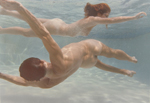 John Ganis (b. 1951)
John Ganis (b. 1951)
Untitled
Chromogenic print
Included in the exhibition The Recent Work of John Ganis, December 28, 1977–January 22,1978
From the exhibition press release dated December 14, 1977:
John Ganis’ photographs of Brighton Beach deal with the movement of bodies in water and on beaches. His images are unique in the way they relate arms, legs, heads and torsos to the density of the ocean, the texture of the sand, and the play of light and shadows from the sun. Ganis has spent hundreds of hours photographing this project using his Nikonos camera to get as close to his subject as possible.
Mark Schwartz (b. 1956)
Untitled
Included in the exhibition The Recent Work of Mark Schwartz, December 28, 1977–January 22, 1978
From the exhibition press release dated December 14, 1977:
Mark Schwartz’s photographs are very personal and a reflection of both his emotions and his observations. He looks at his work as being an exercise in problem solving rather than as finished products. His influences are Emmet Gowin and Nathan Farb. Both have shown him the importance of paying attention to the ones you love through photography. The portraits and nudes in the show of the young woman, Meg, represent his embracement of that understanding. Also represented in this exhibition are Schwartz’s circular images and light drawings. […] This is his first show in New York City.
Harvey Stein (b. 1941)
Untitled
Exhibited ca. 1978
From the author’s note in Stein’s publication Parallels: A Look at Twins:
During one weekend in May 1972, I met three sets of twins. Instantly struck by that coincidence (I hadn’t seen twins in years), I became fascinated with the visual impact of their duplication, which aroused an extreme curiosity about their relationship. Intermittently over the next five and a half years, I interviewed and photographed more than 150 sets of twins, most of them identical and most of them people like the rest of us aside from the accident of their birth. I began to realize that, regardless of how alike identical twins appear to be, the camera can freeze their reality and allow us to see that there are differences between them. And these differences are often as fascinating as the similarities.
Nathan Farb (b. 1941)
“Man with Fur Belt Buckle”
Gelatin silver print from a Polaroid negative
Included in the exhibition Soviets: Photographs of the Russian People, November 1–November 26, 1978
From the preface to Nathan Farb’s publication The Russians:
These photographs are of the people of Novosibirsk, Siberia. […] I had a studio at a large show of American photography that had been sent to Novosibirsk by the U.S. State Department. That show housed several thousand prints ranging from Ansel Adams prints to snapshots of the Kodak processing line. It also housed a fair amount of equipment, a darkroom made of red plexiglass into which people could look, and a studio where people could have their portraits made. I was the American photographer making pictures in that studio.
I worked with Polaroid film. This has both the small positive print that I gave to each subject and a negative from which I made the prints in this book. About ten thousand people a day came to the show (three hundred thousand in all).
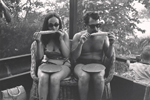 “Couple Eating Corn in New Jersey”
“Couple Eating Corn in New Jersey”
Exhibited ca. 1974
Robert Giard (1939–2002)
“Hedge,” 1976
Included in the exhibition Grounds, January 4–January 28, 1979
David Attie (1920–1983)
Two untitled photographs
Gelatin silver prints from Polaroid negatives
Included in the exhibition Russians and Americans Photographing Themselves, October 24–November 18, 1979
From David Attie’s introduction to his publication Russian Self-portraits:
The plan was that each person being photographed would receive an instant print and I would keep the accompanying negative. Before taking the picture, they could see themselves in the mirror and assume whatever stance and expression they considered most suitable or appealing. Then the studio area was briefly darkened and the camera shutter opened. When the subject was ready, he or she pushed a button at the end of a long wire connected to the lighting system; the push-button triggered the strobe lights; the shutter then closed, the lights came on, and the picture taking was complete.
Sy Rubin (1931–2002)
Untitled
Exhibited ca. 1970s
Larry Fink (b. 1941)
Three untitled photographs
Exhibited ca. 1970s
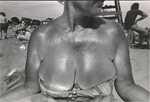 Bruce Gilden (b. 1946)
Bruce Gilden (b. 1946)
Four untitled photographs
Exhibited ca. 1970s
Larry Siegel (b. 1934)
Untitled, 1977
Exhibited November 29–December 30, 1978
Sid Kaplan (b. 1938)
“Jersey City,” 1984
Exhibited ca. 1980s
Arthur Leipzig (b. 1918)
“Death of an Infant, Jungle Hospital, Honduras,” 1962
Exhibited ca. 1980
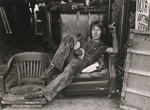 Neil Trager (b. 1947)
Neil Trager (b. 1947)
“Arthur,” 1975
Included in the exhibition Mechanics, March 2–March 21, 1977
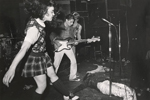 Michael Uffer (b. 1952)
Michael Uffer (b. 1952)
Untitled
Exhibited March 28–April 23, 1979
Anthony Barboza (b. 1944)
“Amiri Baraka, Poet,” 1976
Included in the exhibition Four Photographers from the Visual Arts Referral Service CAPS, May 29–August 15, 1980
The Creative Artists Public Service Program (CAPS) was funded by the New York State Council on the Arts to support individual artists' work in a variety of disciplines.
From a CAPS press release dated May 1980:
The Visual Arts Referral Service is a slide and information registry designed to expose the work of CAPS Fellowship recipients and semi-finalists. Established in 1970, CAPS annually awards Fellowships, ranging from $3,500–$10,000, to Artists in twelve creative fields.
Candice Lenney (b. 1949)
“Laura and Potatoes”
Included in the exhibition Four Photographers from the Visual Arts Referral Service CAPS, May 29–August 15, 1980
Todd Weinstein (b. 1951)
Untitled
Chromogenic print
Included in the exhibition Color Photography in the Urban Environment, September 17–October 18, 1981
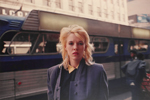 Patrick D. Pagnano (b. 1947)
Patrick D. Pagnano (b. 1947)
"Lexington Avenue, 1981"
Chromogenic print
Included in the exhibition Color Photography in the Urban Environment, September 17–October 18, 1981, and published in his Shot on the Street (New York: Pagnano & Pagnano Design/Photo Inc., 2002)
From the exhibition press release dated August 19, 1981:
The color photographs in this exhibition express the importance of the relationship between people and the contemporary environment. The use of color photography helps emphasize textural qualities and colors indigenous to modern societies. This show is not only concerned with formal photographic properties but with content as an essential and equal part of every photograph. They were taken intuitively, in an open manner, and there is a sense of discovery in each image.
The photographers feel that since the introduction of high-speed kodacolor negative film it is finally possible to work in a manner that breaks down the restrictions that transparencies placed on photographers working in color. Though the subject matter of the photographs is somewhat similar, the concerns of each photographer are personal.
Patrick Pagnano and Todd Weinstein both work professionally doing editorial work and corporate photography in order to finance their personal projects.
Larry Chatman (b. 1951)
Untitled
Included in the exhibition Photographs by Larry Chatman, December 17, 1981–January 10, 1982
From the exhibition press release dated December 1981:
Larry Chatman’s photographs deal with the inter-personal relationships of black men and women in bar rooms of the inner city. Although the project started almost as an accident, the tragic state of these people’s lives becomes quite apparent. Alienation, frustration and power are constantly present. The “white man” is unreachable and unchallengeable, and so they look within their own group for ways to assert their power and establish their worth. Manhood translates into aggressive assertion of power over others through verbal and physical abuse.
Michael Spano (b. 1949)
“Union Square Park, New York,” 1980
Exhibited October 22–November 15, 1981
From the exhibition press release dated October 1, 1981:
Mr. Spano photographs with a 140˚ Wide-Lux camera and most of the images will be printed in a large 20 x 48 inch format.
Spano uses his hand-held panoramic camera to juxtapose human entities in such a way as to create tension. Although his photographs have political content and concern themselves with both the leisure class and working people, they also deal with duality and therefore the whole story rather than one side of the coin. His style is natural, yet organized, and the every day scenes that he photographs have a closeness and immediacy that is profoundly disturbing.
Zeke Berman (b. 1951)
“Table Study,” 1982
Included in the exhibition Four on Fourteenth: Four Photographers from the Visual Arts Referral Service CAPS, April 29–June 26, 1982
From the exhibition press release dated April 1982:
Zeke Berman takes black and white still life photographs with a 4 x 5" view camera. His compositions are constructed, or sculpted specifically for each picture. He brings to his photographs the materials and processes first encountered as a sculptor: casting, modeling, drawing: the “plastic arts.” He uses both optical illusions which suggest the two-dimensional/three-dimensional interplay in pictorial perspective, and explores the use of clay as subject matter in images which reflect the tactile, plastic quality of photographic vision. In several pictures Berman includes newspaper, a material which, in the static atmosphere of the still life, introduces the temporal subject of current events.
Next Section